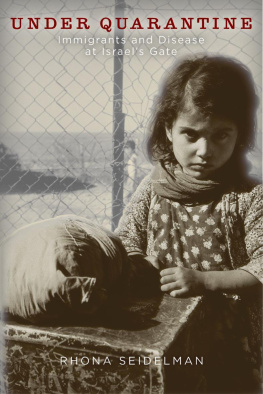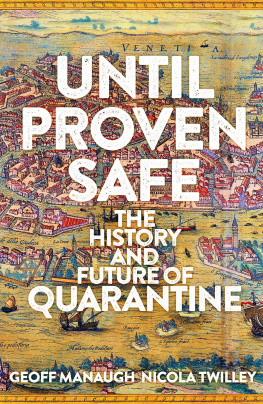Library of Congress Catalog in Publication Control Number: 2019008415
ISBN: 978-1-9788-0838-6 (cloth)
ISBN: 978-1-9788-0837-9 (paper)
ISBN: 978-1-9788-0839-3 (ebook)
A British Cataloging-in-Publication record for this book is available from the British Library.
Copyright 2020 by Rhona Seidelman
All rights reserved
No part of this book may be reproduced or utilized in any form or by any means, electronic or mechanical, or by any information storage and retrieval system, without written permission from the publisher. Please contact Rutgers University Press, 106 Somerset Street, New Brunswick, NJ 08901. The only exception to this prohibition is fair use as defined by U.S. copyright law.
http://www.rutgersuniversitypress.org
Barbed Wire
At the heart of this book is a photograph. In 1949, Robert Capa photographed the fence that separated Israels central immigration camp, Shaar Haaliya, from the area around it. There are three people in the picture, with two standing on the outside. They are facing the third individual, who is moving toward them, crawling under the wires. Although the people and their action are at the center of the image, the frame is dominated by the fence itself. We see that this was no small, token barrier. One year after the establishment of the Jewish state and four years after the Holocaust ended, this image of Israel was dominated by what was a symbol to Jews of European oppression at that time: barbed wire.
This image raises many questions about the motivation for and implementation of so imposing a barrier; about the reactions to it (how it was understood, interpreted, and received); about its failure to act as a deterrent to the people who crawled under it; and about whether there were consequences to this act of defiance for these new immigrants.
This photograph encapsulates a complex and controversial phenomenon. Its story and the many questions it raises are at the heart of the history of Shaar Haaliya and the quarantine there of Jewish immigrants in the first years of the Jewish state.
Figure 1. Crawling under the barbed wire fence. Robert Capa/Magnum Photos.
NOT A QUARANTINE?
Shaar Haaliya was the major immigration processing camp in Israel during the period of the mass immigration that followed the establishment of the state in 1948. The central port of entry during an influx of immigration unprecedented in its speed and in its proportion to the residing population, Shaar Haaliya was intended to create order by systematizing the social, military, and medical processing that the immigrants were required to undergo. Translated, its name means gate of immigration.
At first glance, Shaar Haaliya comes across as a textbook example of an immigrant quarantine station. Photographs of the camp and historiographical references make it clear that Shaar Haaliya was isolated and fenced off and that health concerns played a central role in the camps conception and function. As a separated space where immigrants underwent medical examinations before entering Israel proper, Shaar Haaliya fits well within the definition of quarantine found in the Oxford English Dictionary (OED): More important than the OED, the most significant support for the Shaar Haaliya / quarantine connection comes from the trove of archival documents that deal with that exact issue. This evidence makes a persuasive case for studying Shaar Haaliyas function as a quarantine for Israels early immigrants.
However, other evidence tells a more complicated story. In the existing literature on mass immigration, Shaar Haaliya is referred to in any number of ways: a processing camp, a transit camp, or an immigrant camp.
What makes these reservations particularly intriguing is the many ways they echo the voices coming through in the archival documents. Soon after the establishment of Shaar Haaliya in 1949, authorities were immersed in a discussion of its function and perception as a quarantine. The idea that the central port of arrival for Jewish immigrants to the Jewish state could be a quarantine raised passions and resulted in contentious, turbulent debate. Clearly, the contention and disagreement surrounding this issue continue to reverberate into the present day.
Another more tangible point of contention is evident in the archival documents as well: To what extent was the isolation at Shaar Haaliya enforced? As we see in Capas photograph, the barbed wire fence and the police guards at the camp did not actually prevent people from coming in and out. This gap between prescription and practice was known and discussed widely. The Shaar Haaliya administration knew that these breaches were a regular occurrence, but they did not see them as an indication that the quarantine was failing and that the barbed wire fence and police could be removed. Instead, they continued paradoxically to insist that the quarantine was necessary to protect the rest of the country from diseases borne by the immigrants.
AXES OF CONFLICT
What can be learned from the many conflicts surrounding the Shaar Haaliya quarantine? The lack of consensus, the paradoxes, the level of passion from different quarterssustained over so many yearsall point to the fact that this discussion represents more than just one institution and its health policy: they are valuable indicators of the stakes involved in a medical history of Shaar Haaliya.
The story of the Shaar Haaliya quarantine is the story of the Israeli immigration experiment, a modern experiment of nation building, belonging, and power that is deeply tied to issues of health and disease. What is at stake is the image and the legacy of Shaar Haaliya, the historic gateway for Jewish migration. The conflicts over Shaar Haaliyas quarantine are fundamentally about whether Israels largest, most important gate of immigration is understood as a place where Jews were welcomed to Israel or a place where they were made to feel cast out.
We cannot fully understand Israel until we understand Shaar Haaliya. Here was the countrys crucible. A gateway for nearly half a million immigrants, this is where they began to be changed into the Israeli people and where the Israeli people began to be profoundly changed by them.
The creation of the State of Israel was one of the most transformative events in modern Jewish history. It was established as a homeland and refuge for Jews from across the globe, people whodespite being from vastly different cultures and points of originwere expected to form an integrated, cohesive nation. As a twentieth-century country striving for normalcy and success within Western standards of its day, Israeli administrators would use tools of modern state building (such as regulation, processing, biomedicine, and quarantine) to try to create a functioning, thriving state. But at the same time, this country was anything but normal. This was a profoundly idealized destination, the Promised Land that people had been praying to and about, yearning for, and imagining and mythologizing for millenniaa homeland that, in the Hebrew lexicon, Jews werent immigrating to but ascending toand that people around the world were scrutinizing and holding up to high expectations. Israels migrants arrived with a sense of ownership. After a long history of being forced out or refused entry into countries throughout the worldwith historically tragic outcomeshere was a country from which Jews would not be turned away. For the majority of the people immigrating to Israel in this time, Shaar Haaliya was the gate of entry. It was the first spot in Israel where the historic promise of return was met with the banal realities of bureaucracy and processing, such as impersonal medical examinations and temporary detainment behind barbed wire. The subject of the Shaar Haaliya quarantine brings together these emotionally charged and often conflicting foundations of the Israeli experiment in the first years of statehood. It raises questions about how this new and unusual nation of immigrants was actually going to work, what belonging was going to look like, and which people and ideas would hold power. This is the phenomenon that the Capa photo encapsulates and that this book examines.










